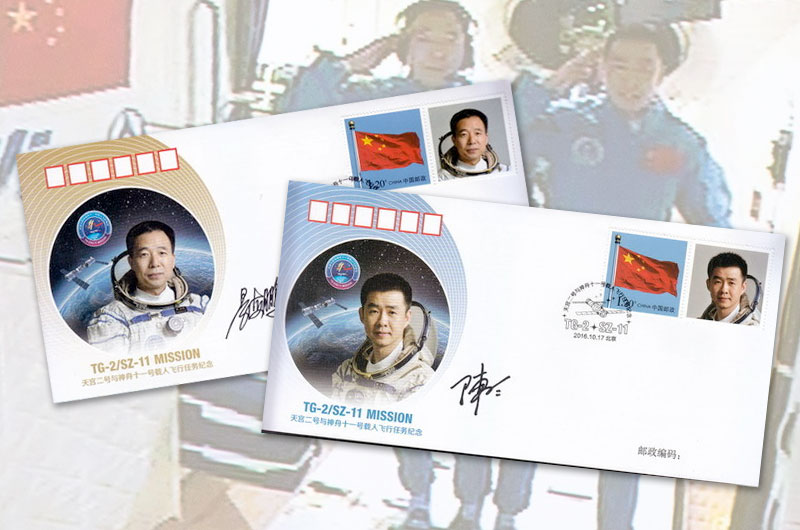Chinese Postage Stamps Honor Shenzhou 11 Taikonauts Now on Space Lab

China's latest astronauts to launch into space have landed on a series of stamps and related postal souvenirs celebrating their ongoing mission.
Jing Haipeng and Chen Dong, who docked their Shenzhou 11 spacecraft to China's Tiangong-2 space lab on Tuesday (Oct. 18) beginning a month-long stay at the complex, are featured on the new postage stamps issued by the China National Philatelic Corporation, which is authorized by the China Post to sell stamp products to the public.
The stamps feature the portraits of Jing and Chen. A third issue depicts the crew's Shenzhou 11-Tiangong 2 mission patch. There is also a dated pictorial cancellation mark that includes an image of the two spacecraft docked together. [Spotting Tiangong-2: How to See China's New Space Lab Overhead]
The China National Philatelic Corporation is also offering stamped envelopes — "covers" as referred to by collectors — that are adorned with photos of the taikonauts and a graphic design showing the launch of their Long March 2F rocket. The stamps and covers, which were first issued on Oct. 17, are offered individually or as sets presented in collectible folders.
Jing, who turned 50 on board Tiangong-2 on Monday (Oct. 24), is the first Chinese astronaut to make three flights into space. As part of his current mission, Jing is filing journals for the state-run Xinhua news agency.
"This is my third time to fly into space," wrote Jing. "This is also my second time to enter a Tiangong. Tiangong-1 was quite good, but Tiangong-2 is much more comfortable. It is perfect in layout, decoration and matching of colors."
Shenzhou 11 is Chen's first spaceflight. He, too, is writing reports about his experience for Xinhua.
Get the Space.com Newsletter
Breaking space news, the latest updates on rocket launches, skywatching events and more!
"Being in space for the first time is unusual," Chen wrote. "My big brother Jing Haipeng has really helped me adjust to life up here, and I am slowly getting used to the feeling of zero gravity, and, you know what — I'm starting to enjoy it more and more."
In addition to penning journals, the astronauts have also begun conducting an array of experiments on Tiangong-2, including working on a student-suggested study of live silkworms to see how the larvae react to the microgravity environment.
The orbiting laboratory, which is intended as a precursor to a Chinese modular space station, is also equipped with a cold atomic clock and a gamma ray burst study, the latter a joint project by Swiss, Polish and Chinese scientists.
Shenzhou 11 is not the first Chinese crewed mission to be honored on the country's stamps. Similar commemorative issues date back to China's first taikonaut in space, Yang Liwei, and his Shenzhou 5 mission in 2003.
China also established a "virtual post office" aboard its first space lab, Tiangong-1, in 2011. The so-called "China Post Space Office" invited the public to e-mail visiting taikonaut crews. They could also purchase stamps and covers via a ground-based counterpart office in Beijing Aerospace City.
See more photos of China's new Shenzhou 11-Tiangong-2 stamps at collectSPACE.
Follow collectSPACE.com on Facebook and on Twitter at @collectSPACE. Copyright 2016 collectSPACE.com. All rights reserved.
Join our Space Forums to keep talking space on the latest missions, night sky and more! And if you have a news tip, correction or comment, let us know at: community@space.com.

Robert Pearlman is a space historian, journalist and the founder and editor of collectSPACE.com, a daily news publication and community devoted to space history with a particular focus on how and where space exploration intersects with pop culture. Pearlman is also a contributing writer for Space.com and co-author of "Space Stations: The Art, Science, and Reality of Working in Space” published by Smithsonian Books in 2018.In 2009, he was inducted into the U.S. Space Camp Hall of Fame in Huntsville, Alabama. In 2021, he was honored by the American Astronautical Society with the Ordway Award for Sustained Excellence in Spaceflight History. In 2023, the National Space Club Florida Committee recognized Pearlman with the Kolcum News and Communications Award for excellence in telling the space story along the Space Coast and throughout the world.










